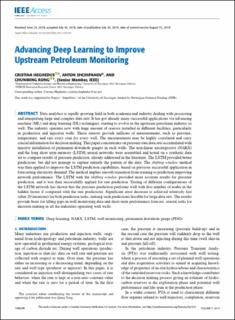| dc.contributor.author | Heghedus, Cristina Viorica | |
| dc.contributor.author | Shchipanov, Anton | |
| dc.contributor.author | Chunming, Rong | |
| dc.date.accessioned | 2020-04-23T06:42:49Z | |
| dc.date.available | 2020-04-23T06:42:49Z | |
| dc.date.created | 2019-08-15T16:21:34Z | |
| dc.date.issued | 2019 | |
| dc.identifier.citation | IEEE Access. 2019, 7 (1), 106248-106259. | |
| dc.identifier.issn | 2169-3536 | |
| dc.identifier.uri | https://hdl.handle.net/11250/2652164 | |
| dc.description.abstract | Data analytics is rapidly growing field in both academia and industry dealing with processing and interpreting large and complex data sets. It has got already many successful applications via advancing machine (ML) and deep learning (DL) techniques, starting to evolve in the upstream petroleum industry as well. The industry operates now with huge amount of sensors installed in different facilities, particularly in production and injection wells. These sensors provide millions of measurements, such as pressure, temperature, and rate every year for every well. The measurements may be highly correlated and carry crucial information for decision making. This paper concentrates on pressure-rate data sets accumulated with massive installation of permanent downhole gauges in such wells. The non-linear autoregessive (NARX) and the long short term memory (LSTM) neural networks were assembled and tested on a synthetic data set to compare results of pressure prediction, already addressed in the literature. The LSTM provided better predictions, but did not manage to capture entirely the pattern of the data. The shifting window method was then applied to improve the LSTM prediction capabilities, based on previous successful application in forecasting electricity demand. The method implies smooth transition from training to prediction improving network performance. The LSTM with the shifting window provided more accurate results for pressure prediction, and it was then successfully applied for rate prediction. Testing of different configurations of the LSTM network has shown that the pressure prediction performs well with less number of nodes in the hidden layers if compared with the rate predictions. Significant error decrease is achieved relatively fast (after 20 iterations) for both prediction tasks, making such predictions feasible for large data sets. The results provide basis for filling gaps in well monitoring data and short-term performance forecast, crucial tasks for decision making in all the industries operating with wells. | |
| dc.language.iso | eng | |
| dc.rights | CC BY 4.0 | |
| dc.rights.uri | https://creativecommons.org/licenses/by/4.0/ | |
| dc.title | Advancing Deep Learning to Improve Upstream Petroleum Monitoring | |
| dc.type | Peer reviewed | |
| dc.type | Journal article | |
| dc.description.version | publishedVersion | |
| cristin.ispublished | true | |
| cristin.fulltext | original | |
| cristin.qualitycode | 1 | |
| dc.identifier.doi | 10.1109/ACCESS.2019.2931990 | |
| dc.identifier.cristin | 1716242 | |
| dc.source.journal | IEEE Access | |
| dc.source.volume | 7 | |
| dc.source.issue | 1 | |
| dc.source.pagenumber | 106248-106259 | |

